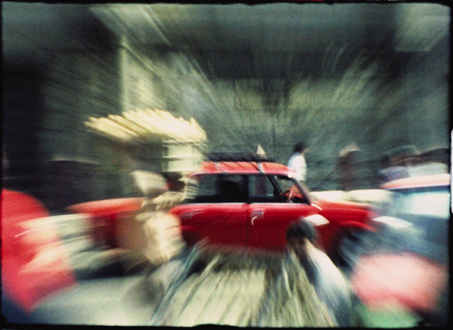
Impakt Festival 2009
14 – 18 October 2009
Utrecht, Netherlands
It is now 100 years since Filippo Marinetti published his controversial “Futurist Manifesto”, in which he described the enthusiasm brought about by the arrival of modern industrial rhythms, driven by a total belief in speed and progress. In his recent “upgrade” of the Manifest, media philosopher Franco Berardi rejects unilateral interpretations of modern speed culture, making a plea for more reflection and autonomy. “The omnipresent and eternal speed”, he writes “is already behind us, in the Internet, so we can forget its syncopated rhymes and find our own singular rhythm”.
Our society is still driven by an insatiable hunger for speed, but during the past decades, the spread of globalisation and the revolution of information and communication technologies have unmistakably led to a new temporal dynamics, emphasizing the increasing importance of connectivity and flexibility. The tyranny of clock time has given way to a complex web of diverging rhythms, cycles and tempos, which stimulate the temporal imagination as never before.
Under the title “Accelerated Living”, the Impakt Festival 2009 focuses on changing notions of time and speed today. During a period of five days, a number of artists, filmmakers, musicians and thinkers will share their views on the construction and intensification of time, and its influence on our perception of reality, and by extension of ourselves. The resulting search for a new engagement with time will be explored in a range of screenings, talks, performances and an exhibition.
Curated by Maria Palacios Cruz & Stoffel Debuysere
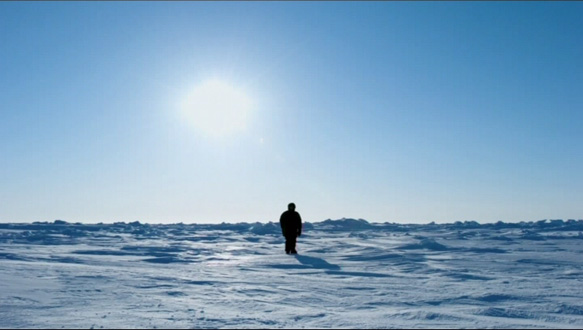
EXPO
14 – 18.10.2009
various locations
“All will be now. Dreams are too fast. You are the first. We are the last.
No sequence to follow. No fear of tomorrow. Kiss of neverness. Life of timelessness
We’ll break the speed of change. we’ll tame eternity.”
– The Pop group, ‘We Are Time’
The passing of time is something we feel intimately familiar with, and yet it continuously slips away from us. Centuries ago, St. Augustine already pointed out that tension: “What is Time? If nobody asks me, I know: but if I were desirous to explain it to one that should ask me, plainly I know not.” The invention of clock time provided a partial solution: time was rationalised, adjusted to the rhythms of growing industrialisation. This transformation – symbolically completed with the introduction of standard time and the division of the world into time zones – resonated deeply in our social and cultural lives. The experience-based understanding of time was replaced by a rigid, linear and numerical logic which has gradually become embedded in our subconscious. The arrival of ICT and globalisation has pierced this unilateral and troublesome relationship. Ironically enough, the dawning of the computer age –the main source of today’s acceleration – has allowed for new perspectives on the role and potential of time. This exhibition takes that openness as a starting point and presents a series of works which each in their own way strive for a particular time awareness. Different dimensions of time, both social and natural, objective and subjective, are unfolded, deformed and combined, in search for new forms of perception and imagination of time.
With works by Julieta Aranda, Jonas Dahlberg, Vadim Fishkin, Glenn Kaino, Guy Sherwin, Thomson & Craighead, Guido van der Werve.
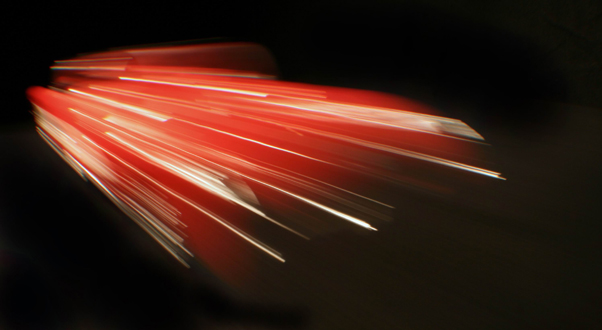
URBAN SCREENS
14 – 18.10.2009
various locations
Thorsten Fleisch : Dromosphere
A research on the representation of four dimensional space-time – described by Albert Einstein in his theory of special relativity – led to the making of this audiovisual sculpture of speed. Using a scale model of a sports cars and a dolly synchronised to the shutter of the camera, Fleisch has produced a capturing visualisation of the phenomenon of speed, which playful references to Paul Virilio and Jeremy Clarkson.
Mark Formanek & Datenstrudel : Standard Time
The recording of a performance in which 70 workers assemble and reassemble a 4 x 12 m wooden replica of a “digital” clock that displays the “real” time: a task that involves 1611 changes over a 24-hour period. This installation offers an ironic comment on the tension between labour, technology and temporality. What better way to waste time than by marking its passage?
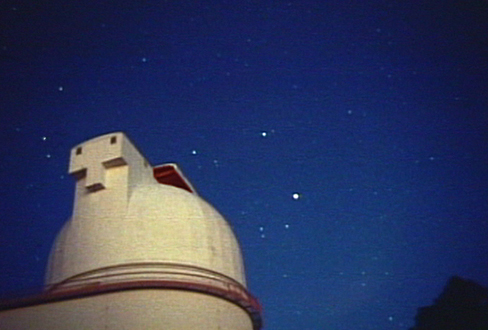
SCREENINGS
16 – 18.10.2009
Filmtheater ’t Hoogt
“Take some time, take some more, time is passing, the time of your life, the earth rotates, seasons come and go, the machine sorts zeros from ones, as another thousand tiny bursts of phosphorescent light dance to the rhythm of the wind and the tide.”
– Chris Welsby
It seems as if time is increasingly out of joint. We no longer experience time as a succession or an acceleration of events, but rather as something adrift in a fragmented world of information stimuli, out of the realm of chronology and linearity. What is the impact of this evolution on our perception patterns? How do the different internal, natural, social and technological rhythms relate to each other and influence our daily sensory perception? What is the role and potential of cinema, together with music, the art form most particularly devoted to the shaping force of time? These and other questions will be explored through a series of contemporary and historic film and video works addressing the relation between space, movement, technology and (our experience of) time.
With works by Gary Beydler, Bruce Conner, Ivan Ladislav Galeta, Chris Garrat, Dryden Goodwin, Dominique Gonzalez-Foerster, Jean–François Guiton, Gerard Holthuis, Philip Hoffman, Peter Hutton, Ken Jacobs, Jim Jennings, Kurt Kren, Malcolm Le Grice, Mark Lewis, Jeanne Liotta, Rose Lowder, Gordon Matta-Clark, Pavel Medvedev, Marie Menken, Dietmar Offenhuber, Rafael Montañez Ortiz, Yo Ota, D.A. Pennebaker, Ilppo Pohjola, Michel Pavlou, Artavazd Pelechian, Norbert Pfaffenbichler, William Raban, Joost Rekveld, Nicolas Rey, Emily Richardson, Guy Sherwin, Morten Skallerud, Michael Snow, Stom Sogo, Scott Stark, Makino Takashi, Leslie Thornton, Andrei Ujica, Chris Welsby, Joyce Wieland, Fred Worden, Iván Zulueta.
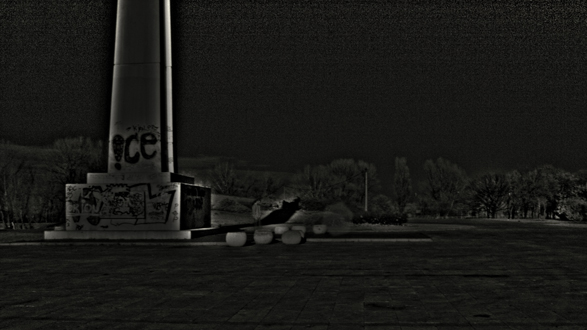
EVENTS
OPENING NIGHT
14.10.2009
Theater Kikker
“We will sing of the multicolored, polyphonic tides of revolution in the modern capitals; we will sing of the vibrant nightly fervor of arsenals and shipyards blazing with the violent electric moons; greedy railway stations that devour smoke-plumed serpents; factories hung on clouds by the crooked lines of their smoke.”
– F. T. Marinetti, ‘Futurist Manifest’
Thomas Köner : The Futurist Manifest
The work of media artist Thomas Köner cannot be easily categorised. For years he was active as a sound engineer, before his project Porter Ricks caused a stir in the European techno landscape of the 1990s. In filmmaker Jürgen Reble he found the perfect collaborator to pursue his interest in the symbiosis of visual and auditory experiences. All these different influences come together in Köner’s recent work, in which his fascination for tone colour has expanded to the moving image, resulting in a series of acclaimed performances and installations. Prompted by the festival theme of “Accelerated Living” and the hundredth anniversary of the Futurist Manifesto, he has composed an “opera digitale” for Impakt, which will be performed with a prepared piano, a digital ”noise orchestra” and a female singer. The sonic sediments of one hundred years of industrialisation and acceleration will be condensed in a multidimensional audiovisual space, where image and sound interact as if “time and space died yesterday”.
Carl Faia: prepared piano & live electronics
Iris Garrelfs: voice & live electronics
Thomas Koner: laptop noise orchestra, visuals
An Impakt production
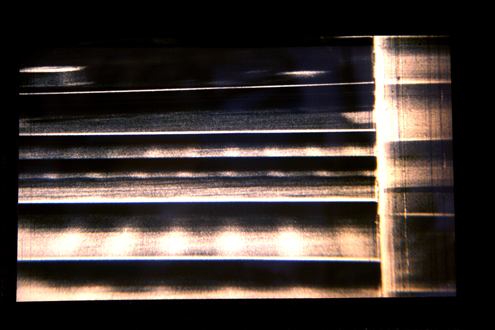
15.10.2009
Theater Kikker
DOPES TO INFINITY
“I have something more cosmic in mind
It’s a warpage of time and it’s bliss for everyone”
– Monster Magnet, ‘Dopes to Infinity’
Guy Sherwin
A key figure in British avant-garde cinema, Guy Sherwin pushes the limits of cinema with his films, installation works and performances, in which he explores film’s fundamental properties: light and time. Since the 1970s he has been working on a series of studies on the illusion of movement and stasis experienced during train travel. For Impakt, he will present a selection of his “train films” in the form of an expanded film performance.
Dirk de Bruyn + Joel Stern
In his work, filmmaker and media artist Dirk de Bruyn deals with the disorientating and traumatic experience of media-saturated environments. His performance ‘LanterNfanten’ for three projectors creates an absorbing space where time is disturbed and compressed as a kind of personal research on bodily trauma and cultural displacement. It will be accompanied by a live soundtrack from composer Joel Stern, merging music concrète, art brut and noise.
Core of the Coalman
Core of the Coalman is one of the alter egos of composer and visual artist Jorge Boehringer, a project in the musical no man’s land between power electronics, noise and contemporary classical music. With violin, his voice and electronics he builds sonic architectures hovering on the edge between chaos and order.
Bruce McClure
A film projector is not only a source of light but also of sound. Nobody understands this better than Bruce McClure who with his immersive performances for multiple projectors creates a pure sensory game of pulsating rhythms and shadows, well beyond the borders of cinematographic time and space. For Impakt he has prepared a unique two-hour performance, which is sure to provide a hypnotic and overwhelming experience.
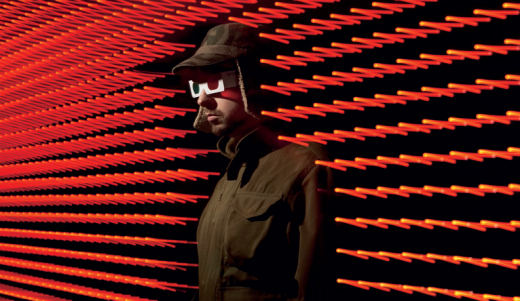
16.10.2009
Tivoli de Helling
SPEED TRIBES
“It is not just a matter of music but of how to live: it is by speed and slowness that one slips in among things, that one connects with something else. One never commences; one never has a tabula rasa; one slips in, enters in the middle; one takes up or lays down rhythms.”
– Gilles Deleuze
Mount Kimbie + James Blake
British breakbeat culture is alive and kicking. The explosion of dubstep has provoked a plethora of sound experiments and cross-overs from which a fresh sound emerges from time to time. One of those surprises is London duo Mount Kimbie who inject melancholic pop sensibility and hybrid rhythmic patterns into dubstep. They are joined live by vocalist James Blake whose exciting debut reconciles jazz, soul and a taste for melodrama with the sound of the imploding metropolis.
Cooly G
This protégé of the cutting edge Hyperdub label drew the attention of the so-called « UK funky » scene last year. It’s not surprising : her spicy but contagious mixture of deep house and dubstep, seasoned with bitter sweet vocals and subtle touches of acid and hardcore is, without a doubt, a fresh wind in the the British club culture. Tribal rhythms and woozy synth chords, deep basses and aching sighs, light vibes and dark undertones : it’s precisely these contrasts that make her music so irresistible!
The Bug + Flowdan
The man behind The Bug is Kevin Martin, who has been reinterpreting industrial, dub and breakbeat since the 1990s. His fascination for intense and dark mutations of electronic rhythms and sub-harmonic frequencies was already present in earlier projects such as God, Techno Animal and Ice. The Bug is the culmination of all these influences : a highly personal exploration of bass culture, with a sound that he self-described as “warped ragga meets heavy electronic dub”. His most recent release London Zoo was praised by several media as one of the most important albums of 2008. MC Flowdan, a key figure of East London’s grime scene, will accompany The Bug as guest artist.
Kode9
In recent years Steve Goodman aka Kode 9 has established himself as one of the most influential names in contemporary electronic music culture. A music producer, theorist and the owner of the celebrated Hyperdub label, he obstinately continues to explore the big city’s sonic fabric, its energy fields and rhythms. Movement, vibration, exaltation, emotion: Kode 9’s music acts like a hyper urban virus that mercilessly gets into our central nervous system.
+ DJ Sonido del Principe (Generation Bass)

17.10.2009
Theater Kikker
ECSTATIC MUTATIONS
“Below the level of sounds and rhythms, music acts upon a primitive terrain, which is the physiological time of the listener. (…) Because of the internal organization of the musical work, the act of listening to it immobilizes passing time; it catches and enfolds it as one catches and enfolds a cloth flapping in the wind.”
– Claude Lévi-Strauss
Thomas Brinkmann
Thomas Brinkmann is one of the foremost figures of the minimal techno movement, which has influenced contemporary music production since the 1990s. His fascination for programmatic and rhythmic structures finds its roots in his background as a drummer and his training as a visual artist, and most particularly in the influence of Minimalism’s principle of reduction. The result is a vast oeuvre of mathematically refined scores made of complex grooves, overtones and doppler effects. In Utrecht he will present for the first time a completely improvised « klick » performance with 8 turntables, a series of vinyl records and a knife.
Arnold Dreyblatt Ensemble
The musical exploration of Dreyblatt, a student of the first generation of New York minimalist composers, is driven by an inclination for rhythmic complexity built on resonance and vibration. During the past decades he has developed a number of new instruments, tuning systems and performance techniques, with which he digs even deeper under the rhythmic surfaces in order to find a rich dynamics of textures and timbers. His work remained obscure for years, until it was brought to attention by musicians such as Jim O’Rourke who described one of his albums as “the first genuinely new sound in maybe 10 years”. He has recently brought together an ensemble with Jörg Hiller, Joachim Schutz and Robin Hayward, which will offer a rare not-to-be-missed concert during Impakt.
Arnold Dreyblatt: Composer, Excited Bass, Laptop
Jörg Hiller: Drums, Automated Electric Guitar
Joachim Schutz: Electric Guitar
Robin Hayward: Amplified Tuba
Oren Ambarchi + Robbie Avenaim
Oren Ambachi uses the electro-acoustic transformation of his guitar as a laboratory for tonal research. The result is an abstract and fragile sound world that continuously searches the borders of time and space. He regularly collaborates with different musicians such as Fennesz, Keith Rowe en sunn0))). This time he will be reunited with his long-time friend percussionist Robbie Avenaim, who explores the limits of the sound spectrum using modified and motorised drums. Together they create a visceral and kinetic audiovisual experience.

SPECIAL EVENTS
“Time is the substance of which I am made. Time is a river which sweeps me along, but I am the river; it is a tiger which mangles me, but I am the tiger; it is a fire which consumes me, but I am the fire.”
– J.L. Borges
18.10.2009
Theater Kikker
Charles Curtis, Carol Robinson & Bruno Martinez
Eliane Radigue’s Naldjorlak I, II, III
The work of French composer Eliane Radigue is first and foremost an exploration of the phenomenological reality of sound : the combination of matter, vibration and resonance which ultimately determines our experience of sound. She began to experiment with electronic feedback in the 1950s, before discovering her medium of choice, the analogue ARP synthesizer. Since 2004 she has composed exclusively for acoustic instruments. ‘Naldjorlak I’, in which the hidden, complex sonority of the cello is fathomed, was developed as a collaboration with renowned cellist Charles Curtis. For the following parts, she required the participation of basset-horn players Carole Robinson and Bruno Martinez. The result is a versatile and volatile sound world, which continuously balances on the verge of perception.
Charles Curtis: cello
Carol Robinson & Bruno Martinez: basset horns
16 – 17.10.2009
location tbc
Leif Inge : 9 Beet Stretch
There are few musical works that speak to the imagination as does Beethoven’s 9th Symphony. But although almost everyone in the Western world can easily hum its melody, this classic composition has not yet given away all its secrets. That’s what Norwegian artist Leif Inge does by digitally stretching out the piece to a length of 24 hours, unveiling its unknown and unheard dimensions. A marathon performance which is sure to provide a peculiar perception of time. In the words of a participant : “I thought I was a fly trapped in honey.”
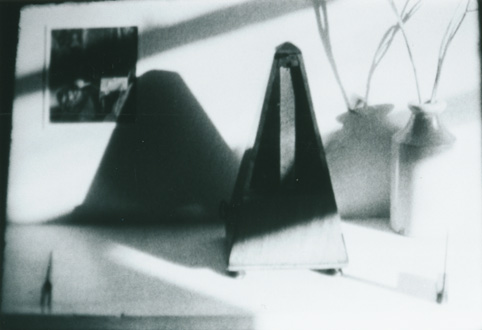
CONFERENCE
“In the sun that is young once only
Time let me play and be
Golden in the mercy of his means”
– Dylan Thomas, ‘Fern Hill’
15.10.2009
Filmtheater ‘t Hoogt
Contemporary science and technology have made possible a temporality which though still based upon clock time, has exploded into countless different time fractions and speeds beyond human comprehension. Today we seem to live in several time zones at the same time, propelled by a variety of internal and external time mechanisms and innumerable rhythms which continuously vibrate, resonate, connect, oscillate and disconnect. How to grasp the temporal complexity that surrounds and occupies us ? What sort of ecologies of time and speed have we developed under the influence of new technologies and what is their impact on our body and senses ? This conference brings together a number of international thinkers who offer new perspectives on our contemporary experience of time and speed.
A day-long programme including contributions by Mike Crang, Dirk de Bruyn, Charlie Gere, Steve Goodman, Glenn Kaino, Sybille Lammes, Carmen Leccardi, Stamatia Portanova, John Tomlinson, and others. In collaboration with the MA New Media & Digital Culture, Department of Media- and Culturestudies, Utrecht University.
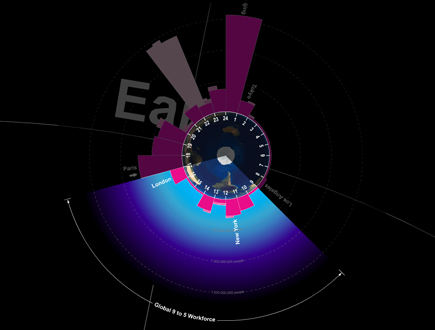
IMPAKT ONLINE
16.10.2009
Internet is often considered as “timeless”, an endless space of connected websites and data files, a media sphere where users can wander about blindly, unaware of time. At the same time we face a growing proliferation of spam, dead links, pop-ups and search queries that lead nowhere. How to define the experience and perception of time spent online? When is information “fresh” ? How do trends develop on the Web? How fast do they wear of? These are the issues addressed by the projects curated by Sabine Niederer for Impakt Online. During the Impakt Festival, these online art projects will be presented in the presence of the artists.
With contributions by Theo Deutinger, Constant Dullaart, Richard Rogers, Daan Odijk